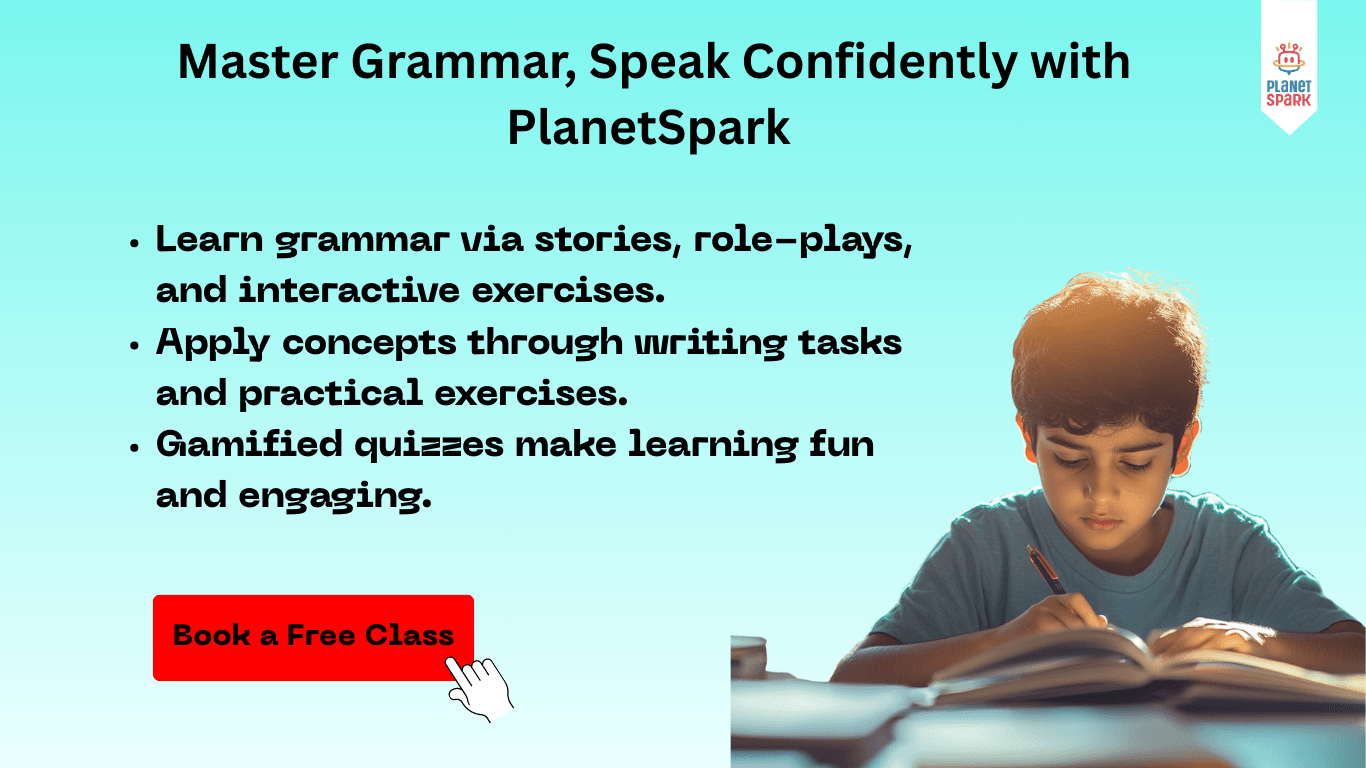Primary Auxiliary Verbs: Rules & Examples

Table of Contents
- What is a Primary Auxiliary Verb?
- Types of Primary Auxiliary Verbs
- What is a Modal Auxiliary Verb?
- Difference Between Primary and Modal Auxiliary Verbs
- Uses and Rules of Primary Auxiliary Verbs
- Primary Auxiliary Verbs Examples
- Helping Verbs in English Grammar Activities
- Benefits of Using Worksheets
- Practical Tips for Parents and Teachers
- Comprehensive Grammar Learning with PlanetSpark’s Expert App
- Building a Strong Grammar Foundation with PlanetSpark
Understanding verbs is essential to mastering English grammar, and primary auxiliary verbs are at the heart of fluent communication. This blog explains what primary auxiliary verbs are, their types, usage, examples, and how you can master them through simple tips and exercises. Whether you’re a student or a parent looking to strengthen your child’s grammar foundation, this guide covers everything you need to know about primary auxiliary verbs in English grammar.
👉 Want your child to master English grammar the smart way? Enrol in the PlanetSpark English Grammar Course, where kids learn through games, stories, and interactive sessions!
What is a Primary Auxiliary Verb?
A primary auxiliary verb (also known as a helping verb) is used to support the main verb in a sentence to form different tenses, voices, and moods. The three primary auxiliary verbs in English are:
👉 Be, Have, and Do.
These verbs help form questions, negatives, continuous tenses, perfect tenses, and emphatic expressions.
For example:
She is reading a book. (Helping verb is forms the present continuous tense.)
They have completed their homework. (Helping verb have forms the present perfect tense.)
I do like pizza! (Helping verb do adds emphasis.)
Without primary auxiliaries, constructing accurate English sentences would be nearly impossible.

Types of Primary Auxiliary Verbs
1. Be – Expressing State and Continuous Actions
The auxiliary verb be is used to form continuous tenses and passive voice structures.
Its forms include: am, is, are, was, were, be, being, been.
Examples:
She is studying English. (Present continuous)
They were watching a movie. (Past continuous)
The project was completed on time. (Passive voice)
Tip:
Use be with -ing verbs (present participles) to form continuous tenses.
2. Have – Showing Possession and Perfect Tenses
The auxiliary verb have is used to form perfect tenses.
Its forms include: have, has, had.
Examples:
I have finished my assignment. (Present perfect)
She had left before I arrived. (Past perfect)
They have been working all day. (Present perfect continuous)
Tip:
Use have/has for present perfect and had for past perfect.
3. Do – Used in Questions, Negatives, and Emphasis
The auxiliary verb do is used to form questions and negatives in the simple present and simple past tenses.
Its forms include: do, does, did.
Examples:
Do you like chocolate? (Question)
She doesn’t play cricket. (Negative)
I did study for the test. (Emphasis)
Tip:
Use do/does for present tense and did for past tense. Never use do with modal verbs or continuous/perfect tenses.
What is a Modal Auxiliary Verb?
A modal auxiliary verb (or simply modal verb) is a helping verb that expresses the speaker’s attitude or mood toward the main verb. Modal auxiliaries don’t change form according to the subject and are always followed by the base form of the verb.
They express possibility, permission, ability, necessity, advice, and obligation.
Common Modal Auxiliary Verbs:
👉 Can, Could, May, Might, Must, Shall, Should, Will, Would, Ought to.
Examples:
She can swim very fast. (Ability)
You must complete your homework. (Obligation)
May I come in? (Permission)
It might rain tomorrow. (Possibility)
We should respect our elders. (Advice)
Key Tip:
While primary auxiliaries help form tenses, modal auxiliaries express meaning beyond tense, they show intention, confidence, or uncertainty.
Difference Between Primary and Modal Auxiliary Verbs
Primary auxiliaries (be, have, do) help form tenses, negatives, and questions.
Modal auxiliaries (can, could, may, might, must, shall, should, will, would) express mood, possibility, or obligation.
| Primary Auxiliary Verbs | Modal Auxiliary Verbs |
|---|---|
| Be, Have, Do | Can, May, Must, Shall, Will, Should, Would |
| Used for forming tenses | Used for expressing attitudes and moods |
| Can act as main verbs | Cannot function as main verbs |
| Example: She is learning. | Example: She can learn. |
Uses and Rules of Primary Auxiliary Verbs
1. Be
Use: Used to form continuous tenses and passive voice.
Examples:
She is reading a book. (Present continuous)
The letter was written by him. (Passive voice)
2. Have
Use: Used to form perfect tenses expressing completed actions.
Examples:
They have gone home. (Present perfect)
He had finished before noon. (Past perfect)
3. Do
Use: Used for forming questions, negatives, and for emphasis in simple present and past tenses.
Examples:
Do you know him? (Question)
They did not come to the party. (Negative)
I do want to help. (Emphasis)
Primary Auxiliary Verbs Examples
I am learning English.
She has completed her project.
Do they speak French?
The cake is being baked now.
He did call you yesterday.
👉Ready to master English grammar? Join a PlanetSpark class today!
Helping Verbs in English Grammar Activities
Practice is key to mastering helping verbs. PlanetSpark offers engaging worksheets that include:
Fill-in-the-blanks focusing on “be,” “have,” and “do.”
Sentence correction exercises to identify auxiliary usage.
Multiple-choice questions testing understanding of auxiliary verbs.
Question-formation and short answer drills to boost fluency.
Benefits of Using Worksheets
Interactive worksheets enable learners to apply grammatical rules practically.
Strengthens understanding and improves both writing and speaking skills.
Makes abstract grammar concepts accessible and fun.
Reinforces lessons with immediate feedback.
Practical Tips for Parents and Teachers
Encourage children to form sentences using “be,” “have,” and “do” daily.
Highlight helping verbs naturally during conversations.
Use PlanetSpark’s worksheets regularly at home or school to reinforce learning.
Practice creating negatives and questions to build fluency and comfort.
Comprehensive Grammar Learning with PlanetSpark’s Expert Approach

Learning grammar is often perceived as difficult, but PlanetSpark transforms this essential skill into an engaging, practical, and enjoyable journey. By combining expert teaching with innovative, activity-based lessons, PlanetSpark ensures that students not only memorize grammar rules but also deeply understand their use in real-life communication. Our approach is specifically tailored to meet the learning needs of urban Indian students, making grammar relatable and relevant.
Here is how PlanetSpark supports comprehensive and effective grammar learning:
Interactive, Activity-Based Lessons:
Instead of rote learning, PlanetSpark uses storytelling, role-plays, games, and real-life dialogues to teach grammar in a fun and meaningful way.Personalized Learning Experience:
Students progress at their own pace with customized lessons that match their individual learning style, ensuring no one is left behind.Integration of Communication Skills:
Grammar learning is combined with speaking, listening, reading, and writing exercises to build holistic language skills and boost confidence across all modes of communication.Clear and Detailed Worksheets:
Practice exercises include fill-in-the-blanks, sentence corrections, and multiple-choice quizzes, all accompanied by detailed answers and explanations to promote independent study.Technology-Enabled Real-Time Feedback:
AI tools and continuous assessments provide instant feedback during practice sessions, helping students identify and correct mistakes promptly.Parental Involvement Through Progress Reports:
Parents receive regular updates on their child’s accuracy, fluency, and overall grammar development, enabling informed support at home.Experienced Educators and Supportive Environment:
Certified instructors bring passion and expertise, fostering a nurturing atmosphere that motivates students to excel and enjoy learning grammar.
By transforming grammar from a challenging subject into an accessible life skill, PlanetSpark equips students with the confidence and clarity needed for academic success and everyday communication.
Building a Strong Grammar Foundation with PlanetSpark
Mastering primary auxiliary verbs is essential for learners to communicate clearly and accurately. With PlanetSpark’s expert guidance and thoughtfully designed worksheets, students develop a solid foundation in English grammar, opening doors to confident speaking, writing, and comprehension.
Our activity-driven and supportive learning environment ensures that every child builds not only strong grammar skills but also the confidence to use English effectively across various contexts. Book a free demo with PlanetSpark today and give your child the tools to shine in English through engaging lessons tailored to their growth.
Discover how PlanetSpark supports holistic learning. Book a free session!
You can also read -
1. English Grammar Verbs Class 1 – Guide with Examples
2. 10 Types of Verbs That a Class 5 Kid Must Know with Tips!
Frequently Asked Questions
A1: The three primary auxiliary verbs in English are be, have, and do. These verbs work together with main verbs to form different verb tenses, questions, negations, and passive voice constructions. For example, “be” helps form continuous tenses and passive voice (e.g., “She is running,” “The cake was baked”), “have” is used to create perfect tenses (e.g., “They have finished”), and “do” is often used in question formation, negation, and for emphasis in simple tenses (e.g., “Do you understand?”, “I do want to help”).
A2: Primary auxiliary verbs can also function as main verbs and change their form to agree with the subject (e.g., “is”/“are,” “has”/“have,” “do”/“does”). They mainly convey grammatical information like tense, voice, or mood. Modal auxiliaries (such as can, will, should, must) express modality , like possibility, permission, or necessity , and do not change form based on the subject. Modal verbs cannot stand alone as main verbs and do not conjugate (e.g., “She can,” not “She cans”).
A3: Yes, “do” is used for emphasis in positive statements particularly in the simple present and simple past tenses. For example, “I do want to go” stresses the speaker’s intention or feeling more strongly than just “I want to go.” This emphatic use of “do” helps to clarify or reinforce a point in spoken or written communication.
A4: Auxiliary verbs are called helping verbs because they assist the main verb by adding grammatical meaning to the sentence. They help express important details such as tense (when an action happens), voice (whether the subject is doing or receiving the action), mood (possibility or necessity), and form questions or negatives. Without auxiliaries, it would be difficult to convey these nuances clearly in English.
A5: PlanetSpark offers well-structured primary auxiliary verbs worksheets and exercises designed for different age groups and learning levels. These include fill-in-the-blank activities, sentence correction, multiple-choice questions, and practice forming questions and negatives. These resources are aimed at deepening understanding and improving fluency in using helping verbs in English grammar. Parents and teachers can also use these worksheets to support effective learning at home or in classrooms
Download Free Worksheets
Personalized Communication Report
Record a video to get a AI generated personalized communication report for your child

Hi There, want to try these
tips for your child with
LIVE with our expert coach?
Let's check your child's
English fluency

